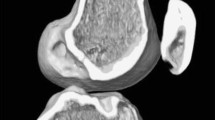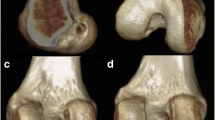Abstract
Purpose
The purpose of this study was to propose an objective description of femoral tunnel position expressed as time of the intercondylar clock in ACL reconstruction using a simple radiograph for the sake of objective discussion and technical improvement. The reproducibility of the method was evaluated in double-bundle (DB) reconstructions.
Methods
The first series of 54 knees in 54 patients who underwent primary “isometric” DB ACL reconstructions from 1995 to 2002 were randomly picked up. The second series of 48 knees in 48 patients with primary “anatomic” DB ACL reconstructions during 2007 were assessed as a recent femoral tunnel position with the same method. All DB reconstructions of ACL with the anteromedial (AM) and posterolateral (PL) bundles were performed with an arthroscopically assisted trans-tibial technique. The o’clock description of femoral tunnel placement was expressed using a weight-bearing posterior–anterior view at 45° of flexion (45° W/B PA view) of the knee. Assessment was undertaken with radiographs 1 year postoperatively.
Results
The o’clock descriptions of femoral tunnel placement resulted in noon 40 min (standard deviation (SD): 10 min) for the AM bundle and one o’clock 40 min (SD: 20 min) for the PL bundle on average in the “isometric” reconstruction. In the “anatomic” reconstruction, the time descriptions of femoral tunnel placement were one o’clock 20 min (SD: 10 min) for the AM bundle and two o’clock 20 min (SD: 20 min) for the PL bundle on average. With the intra-examiner reproducibility assessment in the “anatomic” reconstruction, the differences between first and second assessments averaged 10 min (SD: 7 min) for femoral tunnel placement of the AM bundle and 12 min (SD: 9 min) of the PL bundle. Regarding the inter-examiner reproducibility, the differences between two examiners averaged 9 min (SD: 6 min) for femoral tunnel placement of the AM bundle and 14 min (SD: 9 min) of the PL bundle.
Conclusion
This simple radiographic assessment is reproducible and reliable for clinical use, and useful for the evaluation of ACL reconstructive procedures.



Similar content being viewed by others
References
Aglietti P, Giron F (2001) Anterior cruciate ligament reconstruction for chronic injuries. In: Insall JN, Scott WN (eds) Surgery of the knee, 3rd edn. Churchill and Livingstone, Philadelphia, pp 717–787
Basdekis G, Christel P, Anne F (2009) Validation of the position of the femoral tunnels in anatomic double-bundle ACL reconstruction with 3-D CT scan. Knee Surg Sports Traumatol Arthrosc 17:1089–1094
Bernard M, Hertel P, Hornung H, Cierpinski T (1997) Femoral insertion of the ACL. Radiographic quadrant method. Am J Knee Surg 10:14–21
Colombet P, Robinson J, Christel P, Franceschi JP, Djian P, Bellier G, Sbihi A (2006) Morphology of anterior cruciate ligament attachments for anatomic reconstruction: a cadaveric dissection and radiographic study. Arthroscopy 22:984–992
Giron F, Cuomo P, Aglietti P, Bull AM, Amis AA (2005) Femoral attachment of the anterior cruciate ligament. Knee Surg Sports Traumatol Arthrosc 14:250–256
Hoser C, Tecklenburg K, Kuenzel KH, Fink C (2005) Postoperative evaluation of femoral tunnel position in ACL reconstruction: plain radiography versus computer tomography. Knee Surg Sports Traumatol Arthrosc 13:256–262
Howell SM, Clark JA, Farley TE (1991) A rationale for predicting anterior cruciate graft impingement by the intercondylar roof. A magnetic resonance imaging study. Am J Sports Med 19:276–282
Howell SM, Taylor MA (1993) Failure of reconstruction of the anterior cruciate ligament due to impingement by the intercondylar roof. J Bone Joint Surg 75A:1044–1055
Howell SM, Gittins ME, Gottlieb JE (2001) The relationship between the angle of the tibial tunnel in the coronal plane and loss of flexion and anterior laxity after anterior cruciate ligament reconstruction. Am J Sports Med 29:567–574
Inoue M, Tokuyasu S, Kuwahara S, Yasojima N, Kasahara Y, Kondo E, Onodera S, Yasuda K (2009) Tunnel location in transparent 3-dimensional CT in anatomic double-bundle anterior cruciate ligament reconstruction with the trans-tibial tunnel technique. Knee Surg Sports Traumatol Arthrosc [Epub ahead of print]
Johnson D (2001) Anterior cruciate ligament reconstruction with semitendinosus. In: Insall JN, Scott WN (eds) Surgery of the knee, 3rd edn. Churchill and Livingstone, Philadelphia, pp 693–710
Lorenz S, Elser F, Mitterer M, Obst T, Imhoff AB (2009) Radiographic evaluation of the insertion sites of the 2 functional bundles of the anterior cruciate ligament using 3-dimensional computed tomography. Am Sports Med 37:2368–2376
Manifold SG, Cushner FD, Scott WN (2001) Anterior cruciate ligament reconstruction with bone-patellar- tendon-bone autograft: indications, technique, complications, and management. In: Insall JN, Scott WN (eds) Surgery of the knee, 3rd edn. Churchill and Livingstone, Philadelphia, pp 665–680
Mologne TS, Friedman MJ (2001) Arthroscopic Anterior cruciate reconstruction with Hamstring tendons: indications, surgical technique, complications, and their treatment. In: Insall JN, Scott WN (eds) Surgery of the knee, 3rd edn. Churchill and Livingstone, Philadelphia, pp 681–692
Muneta T, Yamamoto H, Ishibashi T (1995) The effects of tibial tunnel placement and roofplasty on reconstructed anterior cruciate ligament knees. Arthroscopy 11:57–62
Muneta T, Sekiya I, Yagishita K (1999) Two-bundle reconstruction of the anterior cruciate ligament using semitendinosus tendon with endobuttons: operative technique and preliminary results. Arthroscopy 15:618–624
Muneta T, Koga H, Mochizuki T, Ju YJ, Nimura A, Yagishita K, Sekiya I (2007) A prospective randomized study of 4-strand semitendinosus tendon anterior cruciate ligament reconstruction comparing single-bundle and double-bundle techniques. Arthroscopy 23:618–628
Nogalski MP, Bach BR Jr (1994) Acute anterior cruciate ligament injuries. In: Fu FH, Harner CD, Vince KG (eds) Knee surgery. Williams and Wilkins, Baltimore, pp 679–730
Petersen W, Zantop T (2007) Anatomy of the anterior cruciate ligament with regard to its two bundles. Clin Orthop Relat Res 454:35–47
Rosenberg TD, Paulos LE, Parker RD (1988) The forty-five-degree posteroanterior flexion weight-bearing radiograph of the knee. J Bone Joint Surg 70A:1479–1482
Steckel H, Musahl V, Fu FH (2010) The femoral insertion of the anteromedial and posterolateral bundles of the anterior cruciate ligament: a radiographic evaluation. Knee Surg Sports Traumatol Arthrosc 18:52–55
Yagi M, Wong EK, Kanamori A, Debski RE, Fu FH, Woo SL (2002) Biomechanical analysis of an anatomic anterior cruciate ligament reconstruction. Am J Sports Med 30:660–666
Yasuda K, Kondo E, Ichiyama H, Kitamura N, Tanabe Y, Tohyama H, Minami A (2004) Anatomic reconstruction of the anteromedial and posterolateral bundles of the anterior cruciate ligament using hamstring tendon graft. Arthroscopy 20:1015–1025
Yoo JH, Yi SR, Son BK (2008) The prone kneeling view of the intercondylar notch for radiographic assessment of the femoral tunnel position in anterior cruciate ligament reconstruction. Arthroscopy 24:465–471
Zantop T, Wellmann M, Fu FH, Petersen W (2008) Tunnel positioning of anteromedial and posterolateral bundles in anatomic anterior cruciate ligament reconstruction: anatomic and radiographic findings. Am J Sports Med 36:65–72
Zantop T, Diermann N, Schumacher T, Schanz S, Fu FH, Petersen W (2008) Anatomical and nonanatomical double-bundle anterior cruciate ligament reconstruction: importance of femoral tunnel location on knee kinematics. Am J Sports Med 36:678–685
Author information
Authors and Affiliations
Corresponding author
Rights and permissions
About this article
Cite this article
Yamazaki, J., Muneta, T., Koga, H. et al. Radiographic description of femoral tunnel placement expressed as intercondylar clock time in double-bundle anterior cruciate ligament reconstruction. Knee Surg Sports Traumatol Arthrosc 19, 418–423 (2011). https://doi.org/10.1007/s00167-010-1243-9
Received:
Accepted:
Published:
Issue Date:
DOI: https://doi.org/10.1007/s00167-010-1243-9




